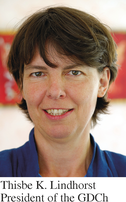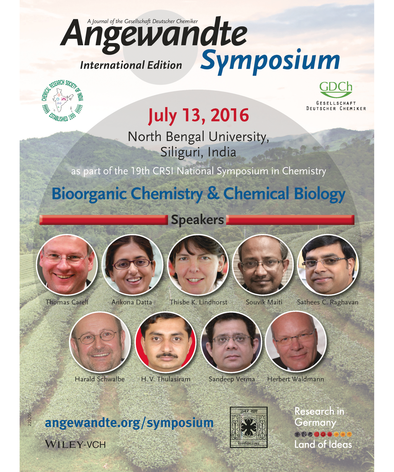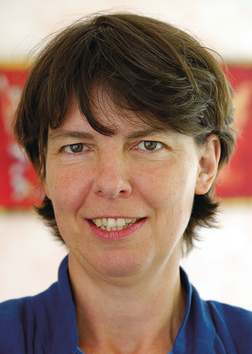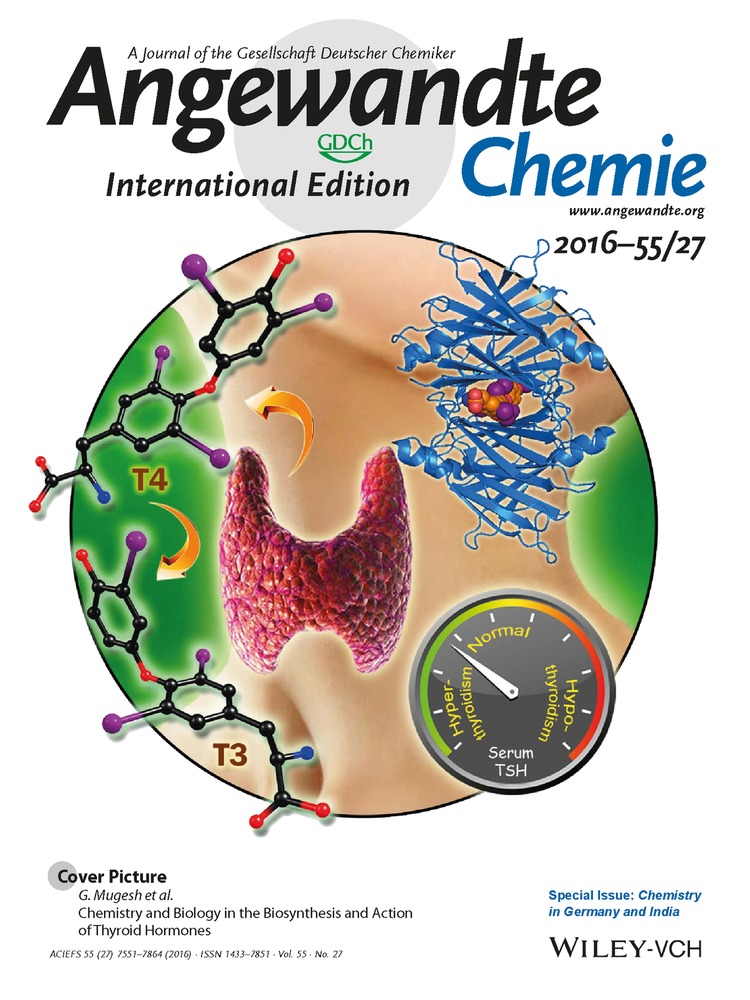Chemistry is a Key Science for the Future of India and the World
Graphical Abstract
The next Angewandte Symposium, which is dedicated to chemical biology and bioorganic chemistry, will take place on July 13, 2016 during the CRSI National Symposium in Chemistry. This is an occasion to reflect on the international nature and societal responsibility of science, and to place the focus on chemical research in India. The number of Communications from India submitted to Angewandte Chemie has increased by 140 % from 2010 to 2015, and the number published by as much as 325 % … Read more in the Editorial by Thisbe Lindhorst.
It is a pleasure for the Gesellschaft Deutscher Chemiker (GDCh; German Chemical Society) to bring German and Indian Chemistry together in this special issue of Angewandte Chemie. Normally the best chemical research from all over the world is published in Angewandte Chemie. Exceptionally (this has only happened previously in the cases of China and Japan, as well as Israel), international research is represented only by groups from Germany and India in this issue. This should inspire scientific exchange between both countries and strengthen the collaboration between their chemical societies. The GDCh has a strong interest in cooperation with the Chemical Research Society of India (CRSI), and this is clearly confirmed by the current issue of Angewandte Chemie.

The GDCh—An International Society
The GDCh is one of the biggest chemical societies in the world, with over 31 000 members. Even though its roots are in Europe, it is active and connected far beyond this one continent. With the aim of promoting chemistry, it has several contacts and partnership agreements throughout the world. The GDCh works intensively with several international organizations, above all the International Union of Pure and Applied Chemistry (IUPAC) and the European Association for Chemical and Molecular Sciences (EuCheMS); moreover, it has contractually agreed cooperation projects with several European and transatlantic chemical societies. One way of marking these collaborations is through bilateral named lectureships. Cooperation agreements have existed for a long time between Germany and China, and since 2012 between Germany and Korea. The GDCh is connected to the Chemical Society of Japan through a long-standing collaboration. Furthermore a series of “Angewandte Symposia”, which are organised jointly with national chemical societies, were established by the GDCh in conjunction with Wiley-VCH for the UNESCO International Year of Chemistry in 2011. Such symposia will take place in Israel in February 2017 as well as in Berlin in September 2017, during the GDCh Wissenschaftsforum 2017, in order to celebrate the 150th anniversary of the Deutsche Chemische Gesellschaft, one of the predecessor organizations of the GDCh. I am particularly pleased that the next Angewandte Symposium, which is dedicated to chemical biology and bioorganic chemistry, will take place on July 13, 2016 during the CRSI National Symposium in Chemistry in Siliguri, in the Indian state of West Bengal.
 I myself will be present in my capacity as President of the GDCh, and I will also give a lecture about the research carried out by my group. I am especially looking forward to fruitful discussions with many Indian colleagues.
I myself will be present in my capacity as President of the GDCh, and I will also give a lecture about the research carried out by my group. I am especially looking forward to fruitful discussions with many Indian colleagues.
Scientific exchange between India and Germany has been supported for many years by German companies and universities, and has been financed by ministries, and DFG and DAAD cooperation programs and student exchange programs. With this issue of Angewandte Chemie and the symposium, the GDCh would like to make it clear that it wants to reinforce both the connection between German and Indian chemistry as well as the dialogue between the societies.
India is the most heavily populated country after China, and has one of the fastest growing economies in the world. It is also home to the oldest cultures that are known to historians. Although German chemists maintain a wide range of contacts with their Indian counterparts, most German people know little or nothing about this enormous country. Is this simply because India is so far from Europe? Or is it rather that India is a country whose mysteries are not readily revealed to outsiders? This is suspected by Gautam R. Desiraju and co-authors in their 2013 Essay (Angew. Chem. Int. Ed. 2013, 52, 114), in which they write: “India is an old, large, and complex country with many hidden talents and untapped potential.” In order to realize this potential, education and training are essential. Since the start of the new millennium, the support of science and education has been a focus of Indian politics, and has resulted in a huge boost for chemical research in India. Indeed, the number of Communications from India submitted to Angewandte Chemie has increased by 140 % from 2010 to 2015, and the number published by as much as 325 %.
In the world of chemistry, the distance between two countries is only as large as this special issue of Angewandte Chemie is thick. On the international stage, science can bring people together in a way that is often not successful in other parts of society. The contribution of science to international understanding is important and valuable, and the GDCh is keen to play its part. Scientists may well have their shortcomings or certain quirks and eccentricities, but these do not get in the way of the fact that science is, and must be, transnational. On June 23, British citizens will vote on whether the country should remain part of the European Union or not. Neither the GDCh nor the Royal Society of Chemistry never even thought of suspending international exchanges or cross-border collaborations. This awareness that research and acquisition of knowledge do not stop at national borders, but rather that international exchange improves the value of our work, connects chemists throughout the whole world.
We should also not forget that chemistry has an important role in the solution of global problems. I would like to mention the 17 Sustainable Development Goals (Table 1) in the “2030 Agenda for Sustainable Development” that were approved on September 25, 2015 at the UN Summit in New York. This agenda should contribute to ending poverty, allowing equality and dignity for all, and protecting our planet from degradation.
1 |
No poverty |
10 |
Reduced inequalities |
2 |
Zero hunger |
11 |
Sustainable cities and communities |
3 |
Good health and well-being |
12 |
Responsible consumption and production |
4 |
Quality education |
13 |
Climate action |
5 |
Gender equality |
14 |
Life below water |
6 |
Clean water and sanitation |
15 |
Life on land |
7 |
Affordable and clean energy |
16 |
Peace, justice, and strong institutions |
8 |
Decent work and economic growth |
17 |
Partnerships for the goals |
9 |
Industry, innovation, and infrastructure |
|
|
The 2030 Agenda for Sustainable Development is a cause that the signatory countries, and their chemical societies such as those in Germany and India, should dedicate themselves to. Hence, the GDCh no longer considers itself to be exclusively a scientific society, but more and more as a community of responsibility and values in chemistry.
I personally wish that modern chemistry in India benefits from the ancient profound wisdom that traditional Indian education has always been devoted to. I also hope that the readers of Angewandte Chemie are inspired by this special issue and wish them both luck and happiness in their research activities.





